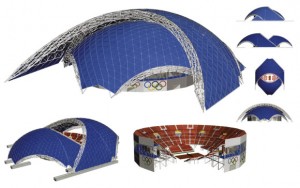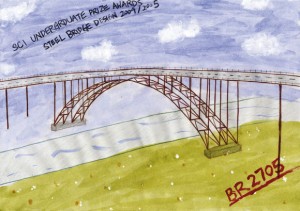Projects and Features
Undergraduates show design flair
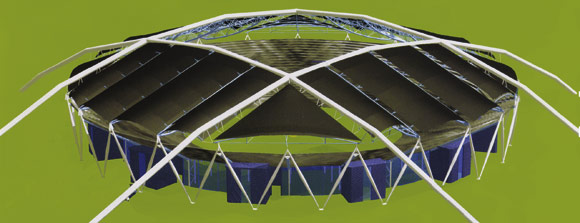
Four intersecting arches support the roof of the winning entry by the University of Sheffield in the structural steelwork competition
Judges were impressed by the quality of achievement in this year’s Undergraduate Engineering Design Awards and, they suggest, rewarding careers await the participants. Paul Wheeler reports.
Students’ submissions to the this year’s Corus-sponsored structural steelwork and steel bridge design competitions demonstrated superb work and highly sought-after skills, the judges said.
Undergraduates from 17 UK universities submitted entries to the competitions, the results of which were announced in July.
Antony Macey, Robert Kettleborough and Mike Butler from the University of Sheffield won the structural steelwork design award, while Dennis Maand Hui Sze Ki from the University of Birmingham took first prize in the bridge design section.
The competition concept is that the student teams act as design consultants working to a client brief. The awards were set up in 1990 to motivate and challenge engineering undergraduates and promote the use of steel in structural design and are open to undergraduates enrolled on UK university courses in civil and structural engineering.
The task in this year’s structural steelwork category was to design a 10,000-capacity Olympic tennis stadium. The bridge competition called for a structure to carry a two-lane dual carriageway over a 440m wide gap, including a central 120m wide ship canal in which no supports were allowed.
Entrants were expected to demonstrate individuality and flair, in addition to showing an understanding of structural design, and to communicate their ideas in a written report with calculations and drawings.
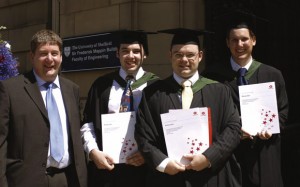
The University of Sheffield’s winning team (l-r) Mike Butler, Antony Macey and Richard Kettleborough, with (far left) Roger Steeper, Corus Market and Product Development Manager
For the structural competition, basic information such as the size of the court area was given, but the brief was left deliberately open. For instance students were given an option of whether to design an open structure or one with a closing roof.
The winning Sheffield team, made up of fourth year MEng students, developed a stadium design based on four principal supporting arches that intersect to frame the tennis court.
They support the front edge of the roof and remove the need for a cantilevered system, as commonly used in sports venues. In addition the huge arches, which span 150m and reach a height of 24m, provide a striking visual impression befitting an Olympic venue.
Dr Buick Davison, course tutor at Sheffield, says the competition gives students the opportunity to follow a structural design from the initial concept through to production of design calculations and construction drawings. This year’s brief, he says, called for “imaginative and innovative use of steelwork and also addressed buildability, deconstruction, health and safety and aesthetic concerns”.
Furthermore, he adds, “the students benefitted from tutorial support from engineers, some of whom were former Sheffield students, at Buro Happold, Arup and SKM Anthony Hunt, who came into the university and ran workshops for the students.” Two of the students from the winning team are already working with participating companies.
According to Dr Davison, the winning team covered all aspects of the brief well. The solution was very well designed and presented, and the drawings were “of a professional quality”. The inclusion of dynamic analysis, he said, “applied knowledge gained from previous studies and was good to see, as it showed they could apply what they had learned elsewhere.”
This observation is supported by the judges who were impressed by the level and wide range of research demonstrated in many of the entries on a diverse range of topics from seating geometry to international case studies.
However the judges did observe that while presentation standards were very good and continue to rise, entrants need to be reminded that “elaborate rendering must be accompanied by sound engineering back-up”. Conversely, in some cases they felt calculations were too voluminous to assimilate.
Overall the judges felt the submissions in the structures competition were of the highest standard in recent experience and “all demanded serious consideration and appraisal”. They said: “the effort expended on the submissions was outstanding. All entrants are to be commended — they produced a rewarding and inspiring set of submissions that were a delight to assess”.
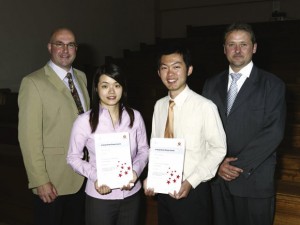
Corus Regional Technical Manager Dave Chapman, with the University of Birmingham’s Bridge Design winning team Erica Hui and Dennis Ma, and Corus Training and Education Manager Andy Graves
The standard was extremely high in the bridge competition too.
Dr Arun Kamtekar, tutor of the winning team from University of Birmingham, explains the approach. “The design provided by our students was symmetrical and could be divided into two parts — the region over the canal and the region either side of it.”
A deck consisting of a six longitudinal steel plate girders acting compositely with a reinforced concrete slab was supported on steel cross girders. Over the canal, each cross girder was supported by four columns each of which bore on to a shallow, three-pin arch spanning 240m across the canal. The load from the arch ribs was carried to the ground via end abutments on a pile cap over several vertical and raking piles.
For the approaches either side of the canal, each cross girder was supported by two columns that carried the load directly to the foundations. Each end of the road was supported on a reinforced concrete abutment. Design of expansion joints and bearings was included.
Dr Kamtekar believes all participating students benefitted greatly from the competition, in particular because it helped them appreciate that a lot of lateral thinking is needed to produce a successful scheme.
Much of this came about through the process his students applied to the brief. Computer calculations were not allowed in the early stages of the project and students had to develop their concepts through sketches and group discussion.
This, says Dr Kamtekar, allowed the students to understand better a number of key messages such as the need to think about the whole structure and not concentrate on just one element of it; and that a number of schemes should be considered before making a decision about which scheme to adopt.
But above this, he believes, the students developed an appreciation that designs evolve gradually and cannot be done in a short time — and that complicated structures can be idealised in a way that allows them to be designed initially by hand.
The judges described the winning entry from Dennis Ma and Erica Hui Sze as “superb undergraduate work”. They felt that the submission demonstrated an excellent development from concept through to the final scheme, with appropriate comments on the reasons for the changes and the implications for structure, cost and aesthetics.
Dr Graham Owen of the Steel Construction Institute said: “I was most impressed by the quality of achievement by a wide range of students from many different backgrounds and universities. The entrants, he said, “demonstrated skills highly sought after by the design profession. I am certain all the finalists can look forward to very rewarding careers.”
Structures competition
Winners: University of Sheffield
Antony Macey, Robert Kettleborough, Mike Butler (Tutor: Buick Davison)
Second: University of Bristol
Jeremy Henley, George Domeyer, Preston Lee Chenk, Philip Man Kin Fung (Tutor: Colin Taylor)
Third (joint): University of Nottingham
Robert Hazelhurst, Amanda Chapham, Andrew Buck, Joe Berrisford (Tutor: Walid Tizani)
Third (joint): University of Leeds
Dimitrios Karypudis (Tutor: Dennis Lam)
Bridges competition
Winners: University of Birmingham
Ma Chun Hang, Hui Sze Ki (Tutor: Arun Kamtekar)
Second: University of Edinburgh
Susan Deeny, Kate Anderson, Niall Corrigan, Richard Morgan, Kenneth Taylor (Tutor: Tim Stratford)
Third: Queens University Belfast
Peter Carson, Martin Kelly, Keith Robson (Tutor: David Sloan)
The Undergraduate Engineering Design Awards are sponsored by Corus, organized by the Steel Construction Institute (SCI), and supported by the British Constructional Steelwork Association Limited (BCSA), The Institution of Civil Engineers, The Institution of Structural Engineers and New Civil Engineer Magazine. Corus also sponsors the Undergraduate Architect Awards.








